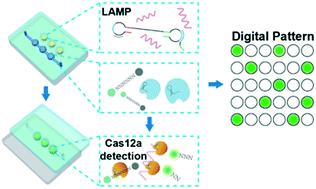Our official English website, www.x-mol.net, welcomes your feedback! (Note: you will need to create a separate account there.)
Parallel multistep digital analysis SlipChip demonstrated with the quantification of nucleic acid by digital LAMP-CRISPR
Lab on a Chip ( IF 6.1 ) Pub Date : 2022-06-07 , DOI: 10.1039/d2lc00284a Ziqing Yu 1 , Lei Xu 1, 2 , Weiyuan Lyu 1 , Feng Shen 1
Lab on a Chip ( IF 6.1 ) Pub Date : 2022-06-07 , DOI: 10.1039/d2lc00284a Ziqing Yu 1 , Lei Xu 1, 2 , Weiyuan Lyu 1 , Feng Shen 1
Affiliation

|
Digital biological analysis compartmentalizes targets of interest, such as nucleic acids, proteins, and cells, to a single event level and performs detection and further investigation. Microfluidic-based digital biological analysis methods, including digital PCR, digital protein analysis, and digital cell analysis, have demonstrated superior advantages in research applications and clinical diagnostics. However, most of the methods are still based on a one-step “divide and detect” strategy, and it is challenging for these methods to perform further parallel manipulation of reaction partitions to achieve “divide, manipulate, and analyze” capabilities. Here, we present a parallel multistep digital analysis (PAMDA) SlipChip for the parallel multistep manipulation of a large number of droplets for digital biological analysis, demonstrated by the quantification of SARS-CoV-2 nucleic acids by a two-step digital isothermal amplification combined with clustered regularly interspaced short palindromic repeats (CRISPR). This PAMDA SlipChip utilizes a “chain-of-pearl” channel with a self-partitioning droplet formation mechanism that does not require the precise alignment of microfeatures for fluidic loading as the traditional SlipChip design. This device can first generate 2400 3.2 nanoliter droplets to perform digital loop-mediated isothermal amplification (LAMP) and then deliver reagents containing Cas12a protein and crRNA to each individual partition in parallel to simultaneously initiate digital CRISPR detection by a simple multistep slipping operation. This PAMDA SlipChip not only provides a promising tool to perform digital CRISPR with a flexible assay and workflow design but can also be applied for a broad range of applications in digital biological analysis that require multistep manipulation of partitions in parallel.
中文翻译:

并行多步数字分析滑动芯片通过数字 LAMP-CRISPR 对核酸进行定量展示
数字生物分析将感兴趣的目标(例如核酸、蛋白质和细胞)划分为单个事件级别,并执行检测和进一步调查。基于微流控的数字生物分析方法,包括数字PCR、数字蛋白质分析和数字细胞分析,在研究应用和临床诊断中显示出优越的优势。然而,大多数方法仍然基于一步的“划分和检测”策略,这些方法对反应分区进行进一步的并行操作以实现“划分、操作和分析”能力具有挑战性。在这里,我们提出了一种并行多步数字分析 (PAMDA) 滑动芯片,用于对大量液滴进行并行多步操作以进行数字生物分析,通过两步数字等温扩增结合成簇的规则间隔短回文重复序列 (CRISPR) 对 SARS-CoV-2 核酸进行定量证明。这种 PAMDA 滑动芯片利用具有自分区液滴形成机制的“珍珠链”通道,不需要像传统滑动芯片设计那样精确对齐流体加载的微观特征。该装置可首先生成 2400 个 3.2 纳升液滴进行数字环介导的等温扩增 (LAMP),然后将含有 Cas12a 蛋白和 crRNA 的试剂并行输送到每个单独的分区,通过简单的多步滑动操作同时启动数字 CRISPR 检测。
更新日期:2022-06-07
中文翻译:

并行多步数字分析滑动芯片通过数字 LAMP-CRISPR 对核酸进行定量展示
数字生物分析将感兴趣的目标(例如核酸、蛋白质和细胞)划分为单个事件级别,并执行检测和进一步调查。基于微流控的数字生物分析方法,包括数字PCR、数字蛋白质分析和数字细胞分析,在研究应用和临床诊断中显示出优越的优势。然而,大多数方法仍然基于一步的“划分和检测”策略,这些方法对反应分区进行进一步的并行操作以实现“划分、操作和分析”能力具有挑战性。在这里,我们提出了一种并行多步数字分析 (PAMDA) 滑动芯片,用于对大量液滴进行并行多步操作以进行数字生物分析,通过两步数字等温扩增结合成簇的规则间隔短回文重复序列 (CRISPR) 对 SARS-CoV-2 核酸进行定量证明。这种 PAMDA 滑动芯片利用具有自分区液滴形成机制的“珍珠链”通道,不需要像传统滑动芯片设计那样精确对齐流体加载的微观特征。该装置可首先生成 2400 个 3.2 纳升液滴进行数字环介导的等温扩增 (LAMP),然后将含有 Cas12a 蛋白和 crRNA 的试剂并行输送到每个单独的分区,通过简单的多步滑动操作同时启动数字 CRISPR 检测。



























 京公网安备 11010802027423号
京公网安备 11010802027423号